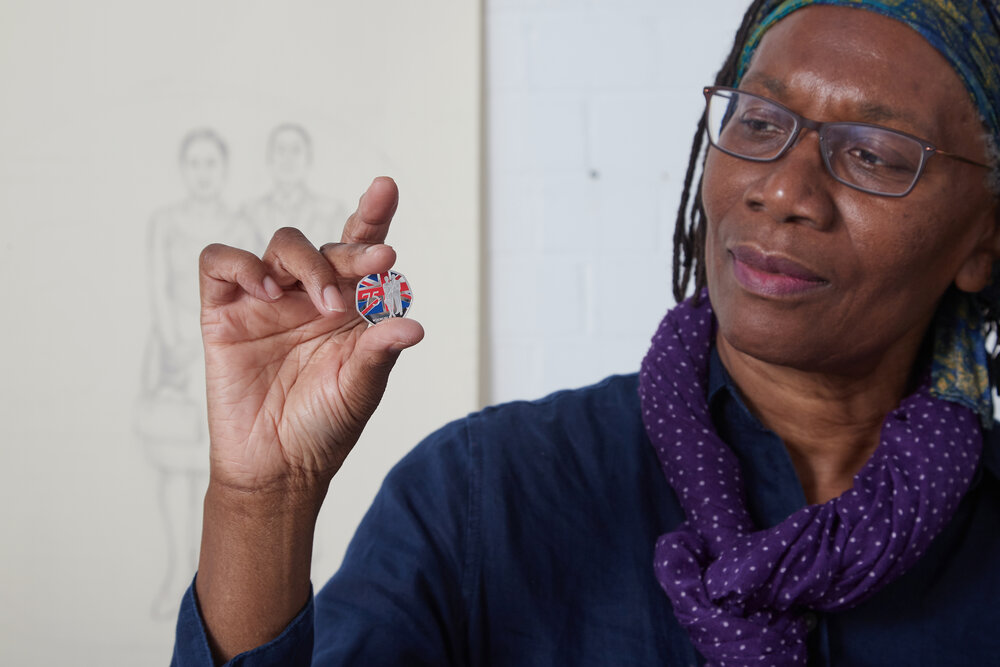THE UNION Jack flag dominates a new 50p coin released to celebrate the Windrush 75th anniversary.
Artist Valda Jackson, who created the design, said the project meant a lot to her as the daughter of Windrush parents.
The Union Jack, depicted alongside two figures representing the Windrush pioneers, is used to reflect issues around belonging, around ownership, questions around our historical and present relationship with all of what that flag represents.
Valda Jackson, designer of the 50p coin said of the coin design: “It’s more than a celebration of one moment, it is an acknowledgment of the real, lived experience of generations of ordinary working people, and though we may have struggled, and we still struggle in so many ways, we and our descendants are, in fact, at home.
“And this is what the image – these figures and the added Union Jack – represents. I am very happy to have my design selected for this coin, which honours our parents and their legacy; and which celebrates our presence, achievements, and contributions that continue to enrich our society.”

The Royal Mint also worked closely with Dr Juanita Cox, a Caribbean Studies specialist at the University of London, throughout the whole process of introducing the commemorative 50p coin marking the anniversary of HMT Empire Windrush’s arrival to the UK.
Rebecca Morgan, Director of Collector Services at The Royal Mint said: “The Royal Mint is committed to representing and celebrating diversity on UK coinage, and as we approach the 75th anniversary of HMT Empire Windrush arrival in the United Kingdom, we are honoured to be marking this important anniversary in British history on an official UK 50p coin.
“Windrush has become symbolic of its passengers and today encompasses the subsequent generations who have played a pivotal role in shaping modern British culture and society since the Second World War.”
Writing in The Voice, Jackson said:
“I am a multidisciplinary artist and writer; creating complex narratives that reflect and interrogate our past and present.
“Both in my visual art and in my writing, my work essentially is about our existence and survival; it’s about individual entitlement, privilege and, above all, dignity.
“When my parents set off from Jamaica in the 1960’s, my two older sisters and I were left with my grandmother and a young aunt. Three years on, we were sent to join them in England.
“I grew up in Birmingham in a strongly religious community of men and women, many of whom also had children who, over time, might be sent-for.
“My experience has been one of growing up in a Caribbean/British culture within a wider English/British one, then working and bringing up my own children while making work that explores our cultural and historical truths.
“I am deeply sensitive to the many reasons, situations, concerns, the dreams, and the hope that compelled my parents and others to take the decision to leave their homes and travel such distance, to work and create for themselves and their children a future they could barely have visualised.
“They lived and worked alongside their counterparts, English, Irish, Scottish, and Welsh, longing, perhaps, to be seen and treated as equal.
“I believe in the power of the image, and the written word – what can be called upon through focus on intense small details – in the emotional capacity of marks laboured over, whether drawn, sculpted or inscribed, their intricacies and subtleties, their poetry, a pattern on a blouse, the form and particulars of a face.
“We see examples in the magnificent terracotta, ivory or cast metal figures and heads from Benin or Ife. In them one sees serenity, repose, and dignity, where even on a scale much smaller than life size they are limitless in their reach and meaning.
“These works have become some of my greatest influences and it is deeply moving to look upon them and recognise in my own images, heads – drawn, painted, or sculpted – those features, that serenity, the dignity of Obas, Kings and Queens.
“It was important, I think, to honour our multiplicity of differences while recognising our similar stories and histories. A country’s flag – this flag – is hugely significant to many.
“I am very pleased The Royal Mint selected this image proposal.
“Adorning the reverse of this commemorative UK 50p coin, Valda’s design depicts two people of the Windrush generation, smartly dressed, as many who arrived on the ship were, standing against a backdrop of the Union flag.
“The image is one of unity, representing the bond between the UK and Commonwealth citizens who helped rebuild the country in its time of need.
“I am very happy to have my design selected for this coin, which honours our parents and their legacy; and which celebrates our presence, achievements, and contributions that continue to enrich our society.”


Comments Form
1 Comment
How does having a Windrush 50p coin assist England’s African-heritage people?
I am shocked at Caribbean people’s infantile mental state.